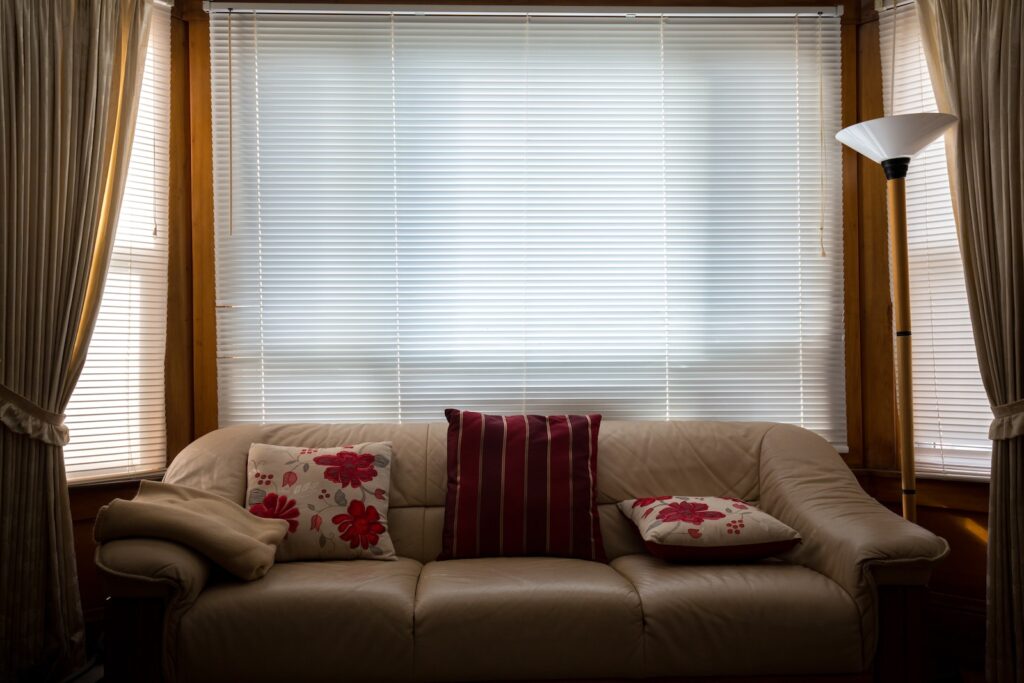When it comes to window treatments, the placement of blinds can make a significant difference in the overall aesthetic of a room. One of the most common debates is whether blinds should be installed inside or outside the window frame.
While both options have their advantages, there are a few key factors to consider before making a decision. In this article, we’ll explore the pros and cons of each placement method, helping you determine which one is right for your home.

Inside the Window Frame
Installing blinds inside the window frame is a popular choice for those who want a clean and minimalist look. It creates a seamless appearance, with the blinds sitting flush against the window glass. Here are some benefits of installing blinds inside the window frame:
- Creates a streamlined look that doesn’t distract from the overall aesthetic of the room.
- Allows for more flexibility in terms of the size and placement of the blinds.
- Can help to block out more light and provide better insulation.
However, there are also some drawbacks to consider when choosing to install blinds inside the window frame:
- May not be suitable for all types of windows, particularly those with shallow frames.
- Can be more difficult to install and adjust, as they need to be precisely measured and fitted.
- May not be as effective at reducing glare, as they sit closer to the window glass.
Outside the Window Frame
On the other hand, installing blinds outside the window frame is another popular option. This involves mounting the blinds above or outside the window frame, creating a more traditional look. Here are some benefits of installing blinds outside the window frame:
- Can help to make a small window appear larger by extending the width of the blinds.
- Easier to install and adjust, as they don’t need to be precisely measured and fitted inside the window frame.
- Can provide better light control, as they can be adjusted to cover more of the window.
However, there are also some drawbacks to consider when choosing to install blinds outside the window frame:
- May not be suitable for all types of windows, particularly those with limited wall space above the window.
- May not provide as much insulation or privacy as blinds installed inside the window frame.
- Can be more prone to damage from wind, rain, and other environmental factors.
Conclusion
So, which option is best for you? Ultimately, the decision comes down to your personal preferences and the specific needs of your space. If you value a clean and minimalist look and want better insulation and privacy, installing blinds inside the window frame may be the way to go. On the other hand, if you prefer a traditional look and want more flexibility in terms of light control, installing blinds outside the window frame may be the better choice. Whichever option you choose, make sure to measure your windows carefully and choose high-quality blinds that will provide years of reliable use.
Frequently Asked Questions
What is the difference between inside and outside mount?
The inside mount is when the blinds are installed inside the window frame, while the outside mount is when the blinds are installed outside the window frame.
The decision to choose between inside and outside mount depends on personal preference, window depth, and other factors such as the presence of decorative molding around the window.
What are the advantages of an inside mount?
One of the advantages of an inside mount is that it provides a cleaner look to the window, as the blinds are installed inside the frame.
Additionally, an inside mount allows for more light control, as the blinds can be adjusted to cover the entire window frame. It also maximizes the amount of space in the room, as the blinds do not protrude out from the window.
What are the advantages of an outside mount?
An outside mount allows for greater flexibility in terms of the size of the blinds, as they can be made to cover the entire window including the frame.
Additionally, an outside mount is ideal for windows with shallow depth, as it allows the blinds to extend beyond the window frame. This can make the window appear larger and more proportional to the room.
How do I measure for an inside mount?
To measure for an inside mount, measure the width and height of the inside of the window frame in three places: the top, middle, and bottom.
Use the smallest measurement for both the width and height to ensure a proper fit. It is also important to measure the depth of the window to ensure that there is enough space for the blinds to be installed.
How do I measure for an outside mount?
To measure for an outside mount, measure the width and height of the area you want to cover with the blinds.
Add at least 2-3 inches to both the width and height to ensure proper coverage. It is also important to measure the depth of the window to determine how far out the blinds will need to extend.
In conclusion, the decision of where to hang blinds ultimately depends on personal preference and the style of your home. If you want to emphasize the architectural beauty of your windows, hanging the blinds outside the frame may be the best option. However, if you want to create a streamlined look and have more control over light and privacy, inside mounting may be the way to go.
It is important to consider the size and shape of your windows, as well as the type of blinds you plan to install. Outside mounting may not be possible for smaller windows or those with unusual shapes. In these cases, inside mounting may be the only option.
Ultimately, the decision of where to hang blinds should be based on your personal style and the practicality of your living space. Whether you choose inside or outside mounting, make sure your blinds fit properly and enhance the overall look and feel of your home.


